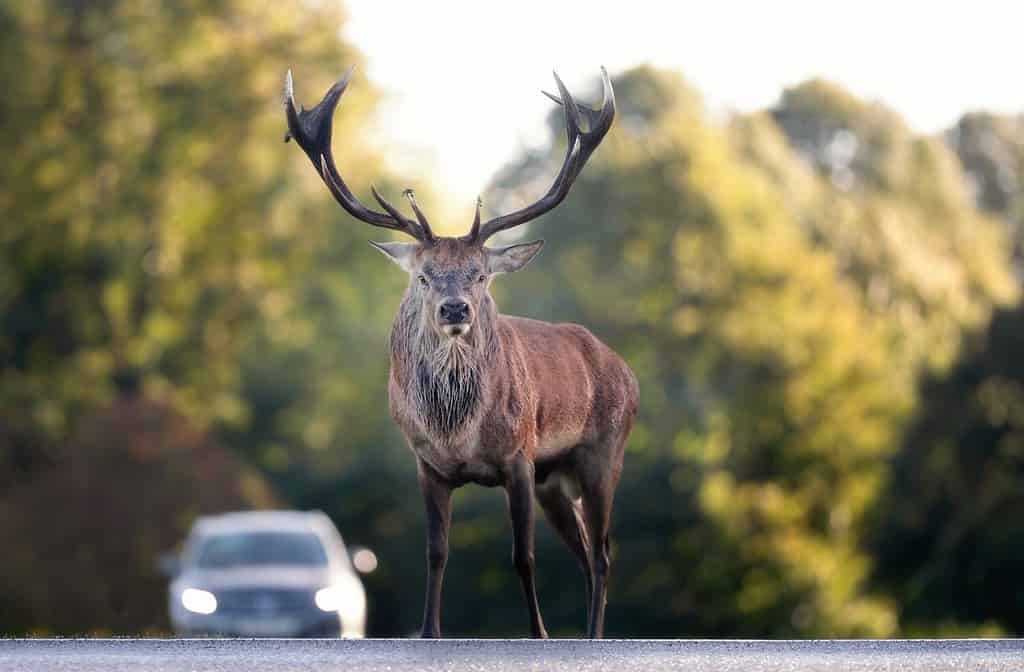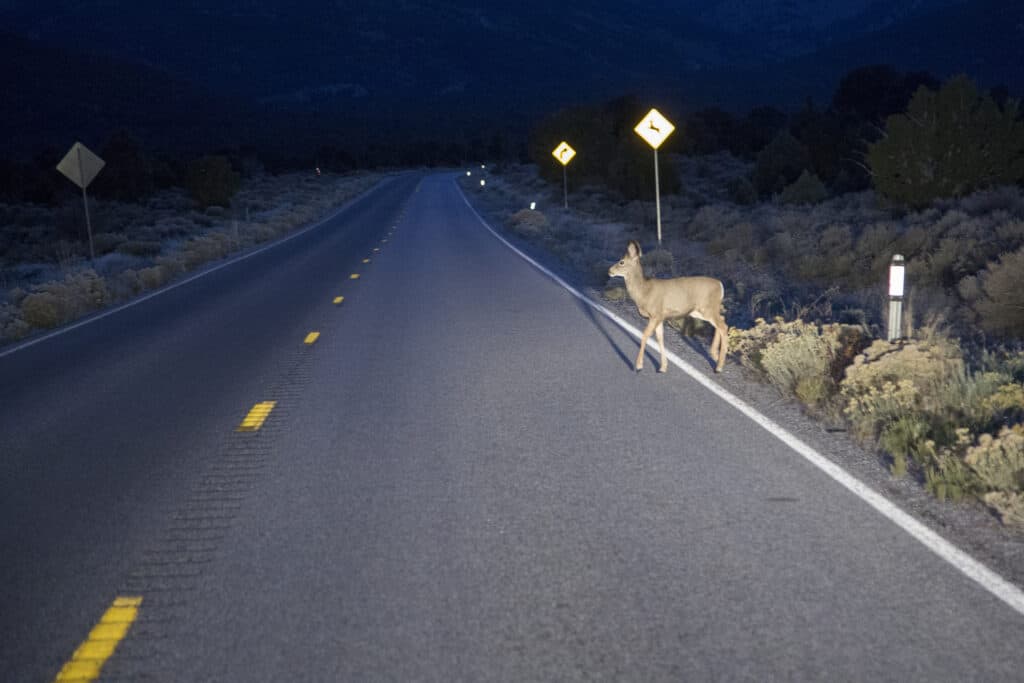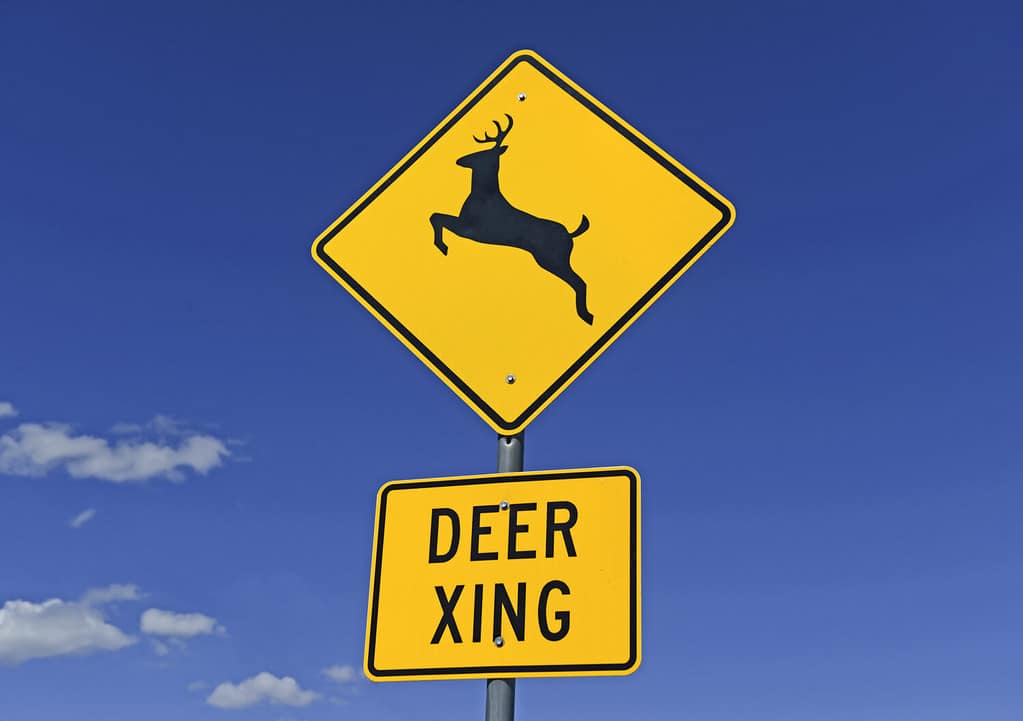Did you know that, according to the U.S. Department of Agriculture, there are nearly two million collisions with large animals on the road each year? Of these animals, there is one involved in vehicular accidents far more than the rest. This animal is, of course, the deer. That’s right. Deer jump in front of cars more than any other animal.
These incidents happen so frequently that many automatically associate animal collisions in general with deer and associate deer with animal collisions. But we’re left to wonder why this experience is so common. What causes deer to be frequently on the roadway? In this article, we will break down exactly what causes this behavior in deer, plus the steps that you can take to ensure you avoid any deer collisions.
How Common Are Deer Collisions?

Collisions with deer are much more common during the fall because that is the deer mating season.
©Giedriius/Shutterstock.com
Though it’s a possibility in an area with a sizable deer population, incidents where deer jump in front of cars are much more significant in some states than others. According to the Insurance Information Institute, information gathered between July 2022 and June 2023 revealed that the five states most likely to experience an animal collision were West Virginia, Montana, Pennsylvania, Michigan, and Wisconsin.
A collision with any animal is bothersome and unfortunate, but when it comes to hitting large animals like deer, things can get deadly. The Insurance Institute for Highway Safety reported that in 2021, 164 fatal accidents involved animal collisions. Though this number is better than prior years, it is still substantial and nothing to scoff at.
These collisions become even more common in the fall when breeding season takes place for deer. Both males and females run around in an attempt to find partners, increasing your chances of you crossing paths with a deer. On top of the deer acting uncharacteristically excitable, this is also the time of year when the days become shorter, and nightfall arrives much faster.
Why Deer Jump in Front of Cars

There are several reasons why accidents involving deer are so common.
©Sean Thomforde/Shutterstock.com
So, what is it exactly that makes deer feel inclined to jump in front of cars? To start off, it’s worth noting that they don’t do this on purpose. It can be easy for it to feel that way, but deer are not ill-intentioned when these collisions happen. Here are the true reasons why these incidents occur so frequently:
- Fear: The simplest explanation is usually the right one, and that’s indeed the case here. The majority of the time, deer will run because they are startled. They don’t realize how large the cars actually are, or how quickly they can go.
- Confusion: Another reason they run in front of cars is because they’re confused. Interestingly enough, they might even run in the direction of the car. You might think this is intentional, but in actuality, they truly believe they are running away.
- Distraction: Deer aren’t crossing the road for fun. There’s a reason why they want to get to the other side. Sometimes this is because there’s a food source, or perhaps they have other deer awaiting them there. If they aren’t thinking about what might hit them as they cross, they might be too distracted by their objective.
- They Didn’t See It Coming: Something interesting about deer is that they look in the foreground of their environment the majority of the time. If something is coming at them from far away, it can take them longer to catch on.
- Blindness: The final explanation is that the deer are temporarily blinded by the brightness of the lights on the road. This interesting phenomenon will be elaborated on in the next section.
Headlights Make Deer Freeze Up

The light from your headlights can stun and temporarily blind a deer, whose pupils are extremely dilated.
©iStock.com/frontpoint
You may have, at one point or another, heard the phrase “like a deer in headlights.” If not that, then perhaps you’ve physically seen a deer get stunned by the shining lights of oncoming traffic. Many believe that the reason deer are struck motionless in the presence of these lights is because they’re startled. This might be part of the reason, but scientifically speaking there is another explanation.
While deer vision is far from perfect, it isn’t as poor as people believe. Since their eyes are at the bad of their heads, for instance, they have great peripheral vision! The reason why deer jump in front of cars in the evening has little to nothing to do with their ability to see at night. In fact, the time when the eyes of deer work the best is after it gets dark. This excellent night vision is actually the very same reason why their vision fails in the face of a vehicle!
You see, their pupils become incredibly dilated in the evenings to help them see everything they need to. When they’re unexpectedly faced with the bright lights of traffic, they are stunned and shocked at the sudden brightness. Think about it like this- when you look at a bright light for too long, and then quickly look away, how much can you really see?
Tips For Avoiding Deer Collisions

Despite being common, accidents involving deer are avoidable when you use awareness and caution.
©nyker/Shutterstock.com
Deer collisions might be common, but they aren’t unavoidable. If you understand why deer jump in front of cars, and the kinds of signs to look out for, you can help yourself to avoid the possibility of getting into an accident. Here are some of the best tips for avoiding these collisions.
- Don’t engage in distracted driving while in a deer-populated area. This means no texting, no eating, and no phone calls. Always stay alert to stay safe.
- Pay special attention to any street signs warning you of dense deer populations. Awareness of your surroundings plays a key role in your safety.
- If you do see a deer further down the road, honk your horn. Make sure to hold it down for a few seconds. This noise is likely to scare the deer off and get them away from the road.
- Always remember that deer frequently live and move in numbers. Never assume that a deer is alone. This means that, if you see one deer safely cross the street, wait a few moments to keep driving. You never know when another one could follow behind!
How Insurance May Respond To You Hitting A Deer
If a deer jumps in front of your car, the good news is that it might be covered by your insurance. Since deer collisions can cost upwards of $4,500 in medical and vehicular expenses, having that covered can make a world of a difference. That being said, this coverage does depend on several things. Most insurance companies cover deer collisions under comprehensive car insurance. However, it may also depend on the manner in which you received the damage.
The question would be whether or not you received damage as a result of your collision with the animal, or if you received the damage from swerving to avoid hitting the animal. As unfortunate as this may be, insurance providers might claim the accident is your fault if you swerve and take damage. This won’t impact whether or not they provide coverage, though. It will just impact your insurance rates, with the possibility of heavily increasing your premiums.
Thank you for reading! Have some feedback for us? Contact the AZ Animals editorial team.








